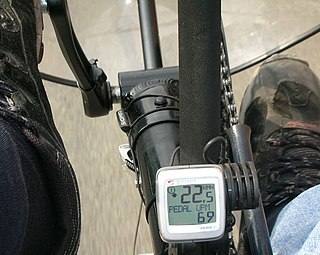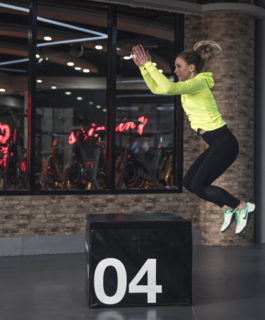Related Research Articles

Running is a method of terrestrial locomotion allowing humans and other animals to move rapidly on foot. Running is a type of gait characterized by an aerial phase in which all feet are above the ground. This is in contrast to walking, where one foot is always in contact with the ground, the legs are kept mostly straight and the center of gravity vaults over the stance leg or legs in an inverted pendulum fashion. A feature of a running body from the viewpoint of spring-mass mechanics is that changes in kinetic and potential energy within a stride occur simultaneously, with energy storage accomplished by springy tendons and passive muscle elasticity. The term running can refer to any of a variety of speeds ranging from jogging to sprinting.

A triathlon is an endurance multisport race consisting of swimming, cycling, and running over various distances. Triathletes compete for fastest overall completion time, racing each segment sequentially with the time transitioning between the disciplines included. The word is of Greek origin, from τρεῖς or treis (three) and ἆθλος or athlos (competition).
Period may refer to:

In sport, racing is a competition of speed, against an objective criterion, usually a clock or to a specific point. The competitors in a race try to complete a given task in the shortest amount of time. Typically this involves traversing some distance, but it can be any other task involving speed to reach a specific goal.

A four-strokeengine is an internal combustion (IC) engine in which the piston completes four separate strokes while turning the crankshaft. A stroke refers to the full travel of the piston along the cylinder, in either direction. The four separate strokes are termed:
- Intake: Also known as induction or suction. This stroke of the piston begins at top dead center (T.D.C.) and ends at bottom dead center (B.D.C.). In this stroke the intake valve must be in the open position while the piston pulls an air-fuel mixture into the cylinder by producing vacuum pressure into the cylinder through its downward motion. The piston is moving down as air is being sucked in by the downward motion against the piston.
- Compression: This stroke begins at B.D.C, or just at the end of the suction stroke, and ends at T.D.C. In this stroke the piston compresses the air-fuel mixture in preparation for ignition during the power stroke (below). Both the intake and exhaust valves are closed during this stage.
- Combustion: Also known as power or ignition. This is the start of the second revolution of the four stroke cycle. At this point the crankshaft has completed a full 360 degree revolution. While the piston is at T.D.C. the compressed air-fuel mixture is ignited by a spark plug or by heat generated by high compression, forcefully returning the piston to B.D.C. This stroke produces mechanical work from the engine to turn the crankshaft.
- Exhaust: Also known as outlet. During the exhaust stroke, the piston, once again, returns from B.D.C. to T.D.C. while the exhaust valve is open. This action expels the spent air-fuel mixture through the exhaust valve.

In the armed services, a military cadence or cadence call is a traditional call-and-response work song sung by military personnel while running or marching. In the United States, these cadences are sometimes called jody calls or jodies, after Jody, a recurring character who figures in some traditional cadences; Jody refers to the man with whom a serviceman's wife/girlfriend cheats while he is deployed.
Indoor cycling, often also called spinning, as an organized sport, is a form of exercise with classes focusing on endurance, strength, intervals, high intensity and recovery, and involves using a special stationary exercise bicycle with a weighted flywheel in a classroom setting. When people took cycling indoors in the late 19th century, whether for reasons of weather or convenience, technology created faster, more compact and efficient machines over time. The first iterations of the stationary bike ranged from strange contraptions like the Gymnasticon to regular bicycles placed atop rollers.

A climbing specialist or climber, also known as a grimpeur, is a road bicycle racer who can ride especially well on highly inclined roads, such as those found among hills or mountains.
High-intensity training (HIT) is a form of strength training popularized in the 1970s by Arthur Jones, the founder of Nautilus. The training focuses on performing quality weight training repetitions to the point of momentary muscular failure. The training takes into account the number of repetitions, the amount of weight, and the amount of time the muscle is exposed to tension in order to maximize the amount of muscle fiber recruitment.

Strength training or resistance training involves the performance of physical exercises which are designed to improve strength and endurance. It is often associated with the use of weights. It can also incorporate a variety of training techniques such as calisthenics, isometrics, and plyometrics.

Sporting equipment, also called sporting goods, are the tools, materials, apparel, and gear used to compete in a sport and varies depending on the sport. The equipment ranges from balls, nets, and protective gear like helmets. Sporting equipment can be used as protective gear or a tool used to help the athletes play the sport. Over time, sporting equipment has evolved because sports have started to require more protective gear to prevent injuries. Sporting equipment may be found in any department store or specific sporting equipment shops.

In cycling, cadence is the number of revolutions of the crank per minute; this is the rate at which a cyclist is pedalling/turning the pedals. Cadence is directly proportional to wheel speed, but is a distinct measurement and changes with gearing—which determines the ratio of crank rpm to wheel rpm.

Aruba sent a delegation to compete at the 1996 Summer Olympics in Atlanta, United States from 19 July to 4 August 1996. This was Aruba's third appearance at a Summer Olympic Games since separating from the Netherlands Antilles. The Aruban delegation consisted of three competitors, track and field athlete Miguel Janssen, weightlifter Junior Faro, and cyclist Lucien Dirksz. Janseen was eliminated in the first round of the men's 200 metres, Faro finished 21st in the men's middleweight, and Dirksz failed to finish his event.

Sports nutrition is the study and practice of nutrition and diet with regards to improving anyone's athletic performance. Nutrition is an important part of many sports training regimens, being popular in strength sports and endurance sports. Sports nutrition focuses its studies on the type, as well as the quantity of fluids and food taken by an athlete. In addition, it deals with the consumption of nutrients such as vitamins, minerals, supplements and organic substances that include carbohydrates, proteins and fats.

Brian Clifford Walton is a Canadian cycling coach and former professional road and track cyclist. His racing career spanned 18 years, racing professionally for North American pro teams 7-Eleven, Motorola, and Saturn. He represented Canada at the Pan American Games, Commonwealth Games, and the Olympic Games in 1988, 1996 and 2000. He won a silver medal in the points race at the 1996 Summer Olympics in Atlanta, Georgia. Walton was inducted into the BC Sports Hall of Fame in 2006.
Athletics is a term encompassing the human competitive sports and games requiring physical skill, and the systems of training that prepare athletes for competition performance. Athletic sports or contests are competitions which are primarily based on human physical competition, demanding the qualities of stamina, fitness, and skill. Athletic sports form the bulk of popular sporting activities, with other major forms including motorsports, precision sports, extreme sports and animal sports.
A GPS watch is a device with integrated GPS receiver that is worn as a single unit strapped onto a wrist, in the manner of a bracelet. The watch can have other features and capabilities depending on its intended purpose and be a smartwatch. GPS watches are most often used for sports and fitness purposes. Many can connect to external sensors by the wireless ANT+ protocol, and/or to a computer by USB to transfer data and configuration. Common sensors used are heart rate monitors and footpods. A footpod can be used to supplement or replace GPS data, such as providing treadmill speed and distance for the watch to log and share. Recharging by USB is commonplace.

The Commonwealth Arena and Sir Chris Hoy Velodrome, known for sponsorship reasons as the Emirates Arena, is an indoor arena and velodrome in Dalmarnock, Glasgow, Scotland. Built for the 2014 Commonwealth Games, these venues hosted the badminton and track cycling events. Situated opposite Celtic Park in the East End of Glasgow, the complex is the headquarters of Sportscotland and Scottish Cycling.
Underwater cycling is stunt, usually done for charity, in which a rider wears scuba diving gear and rides a bicycle in an underwater course. The Underwater Bike Race is an annual charity fundraiser held in North Carolina.

Power training typically involves exercises which apply the maximum amount of force as fast as possible; on the basis that strength + speed = power. Jumping with weights or throwing weights are two examples of power training exercises. Regular weight training exercises such as the clean and jerk and power clean may also be considered as being power training exercises due to the explosive speed required to complete the lifts. Power training may also involve contrasting exercises such as heavy lifts and plyometrics, known as complex training, in an attempt to combine the maximal lifting exertions with dynamic movements. This combination of a high strength exercise with a high speed exercise may lead to an increased ability to apply power. Power training frequently specifically utilises two physiological processes which increase in conjunction with one another during exercise. These are deep breathing, which results in increased intra-abdominal pressure; and post-activation potentation, which is the enhanced activation of the nervous system and increased muscle fibre recruitment. Power training programmes may be shaped to increase the trainee's ability to apply power in general, to meet sports specific criteria, or both.
References
- ↑ Berg, Jared (22 July 2004). "Running with a Higher Cadence". Archived from the original on 28 February 2008.